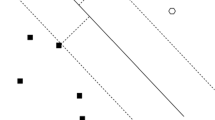Abstract
Traditionally, robust and fuzzy support vector machine models are used to handle the binary classification problem with noise and outliers. These models in general suffer from the negative effects of having mislabeled training points and disregard position information. In this paper, we propose a novel method to better address these issues. First, we adopt the intuitionistic fuzzy set approach to detect suspectable mislabeled training points. Then we omit their labels but use their full position information to build a semi-supervised support vector machine (\(\mathrm {S^3VM}\)) model. After that, we reformulate the corresponding model into a non-convex problem and design a branch-and-bound algorithm to solve it. A new lower bound estimator is used to improve the accuracy and efficiency for binary classification. Numerical tests are conducted to compare the performances of the proposed method with other benchmark support vector machine models. The results strongly support the superior performance of the proposed method.



Similar content being viewed by others
References
Adankon, M., Cheriet, M., & Biem, A. (2009). Semisupervised least squares support vector machine. IEEE Transaction Neural Networks and Learning Systems, 20, 1858–1870.
Ai, Z., Xu, Z., & Lei, Q. (2017). Limit properties and derivative operations in the metric space of intuitioistic fuzzy numbers. Fuzzy Optimization and Decision Making, 16, 71–87.
An, W., & Liang, M. (2013). Fuzzy support vector machine based on within-class scatter for classification problems with outliers or noises. Neurocomputing, 110, 101–110.
Atanssov, K. (1986). Intuitionistic fuzzy sets. Fuzzy Sets and Systems, 20, 87–96.
Bache, K., & Lichman, M. (2013). UCI machine learning repository. School of Information and Computer Science, University of California. http://archive.ics.uci.edu/ml.
Bai, Y., Niu, B., & Chen, Y. (2013). New SDP models for protein homology detection with semi-supervised SVM. Optimization, 62, 561–572.
Billionnet, A., & Elloumi, S. (2007). Using a mixed integer quadratic programming solver for the unconstrained quadratic 0–1 problem. Mathematical Programming, 109, 55–68.
Chapelle, O., Schölkopf, B., & Zien, A. (2006). Semi-supervised learning. Cambridge: MIT press.
Cristianini, N., & Shawe-Taylor, J. (2000). An introduction to support vector machines and other kernel-based learning methods. Cambridge: Cambridge University Press.
Gou, X., & Xu, Z. (2017). Exponential operations for intuitionistic fuzzy numbers and interval numbers in multi-attribute decision making. Fuzzy Optimization and Decision Making, 16, 183–204.
Grant, M., & Boyd, S. (2010). CVX: Matlab software for disciplined programming, version 1.2. Technical report. http://cvxr.com/cvx.
Ha, M., Wang, C., & Chen, J. (2013). The support vector machine based on intuitionistic fuzzy number and kernel function. Soft Computing, 4, 635–641.
He, Q., & Wu, C. (2011). Membership evaluation and feature selection for fuzzy support vector machine based on fuzzy rough sets. Soft Computing, 15, 1105–1114.
Horn, R. (1990). The hadamard product. Proceedings of the American Mathmatical Society, 40, 87–89.
Huang, H., & Liu, Y. (2002). Fuzzy support vector machines for pattern recoginition and data mining. International Journal of Fuzzy Systems, 4, 826–835.
Huang, X., Shi, L., & Suykens, J. (2014). Support vector machine classifier with pinball loss. IEEE Transactions on Pattern Analysis, 36, 984–997.
Lee, C., Wang, S., Jiao, F., Schuurmans, D., & Greiner, R. (2007). Learning to model spatial dependency: Semi-supervised discriminative random fields. In 19th International Conference on Advances in Neural Information Processing System.
Leski, J. (2004). An \(\epsilon \)-margin nonlinear classifier based on fuzzy if-then rules. IEEE Transactions on Systems Man Cybernetics: Part B, 34, 68–76.
Lin, C., & Wang, S. (2003). Fuzzy support vector machine. IEEE Transactions on Neural Networks and Learning Systems, 13, 464–471.
Lu, C., & Guo, X. (2015). Convex reformulation for binary quadratic programming problems via average objective value maximization. Optimization Letters, 9, 523–535.
Sturm, J. (1999). SeDuMi 1.02, a Matlab tool box for optimization over symmetric cones. Optimization Methods and Software, 11&12, 625–653.
Tian, Y., & Luo, J. (2017). A new branch-and-bound approach to semi-supervised support vector machine. Soft Computing, 21, 245–254.
Zhang, Y., & Chi, Z. (2008). A fuzzy support vector classifier based on bayesian optimization. Fuzzy Optimization and Decision Making, 7, 75–86.
Zhu, X. (2006). Semi-supervised learning literature survey. Technical report, University of Wisconsin-Madison.
Zhu, X., & Goldberg, A. (2009). Introduction to semi-supervised learning. New York: Morgan and Claypool.
Acknowledgements
Tian’s research has been supported by National Natural Science Foundation of China Grants #11401485 and #71331004. Deng’s research has been supported by National Natural Science Foundation of China Grant #11501543 and Scientific Research Foundation of UCAS Grants #Y65201VY00 and #Y65302V1G4. Fangs research has been supported by the US Army Research Office Grant #W911NF-15-1-0223. Luo’s research has been supported by National Natural Science Foundation of China Grant #71701035.
Author information
Authors and Affiliations
Corresponding author
Rights and permissions
About this article
Cite this article
Tian, Y., Deng, Z., Luo, J. et al. An intuitionistic fuzzy set based S\(^3\)VM model for binary classification with mislabeled information. Fuzzy Optim Decis Making 17, 475–494 (2018). https://doi.org/10.1007/s10700-017-9282-z
Published:
Issue Date:
DOI: https://doi.org/10.1007/s10700-017-9282-z




